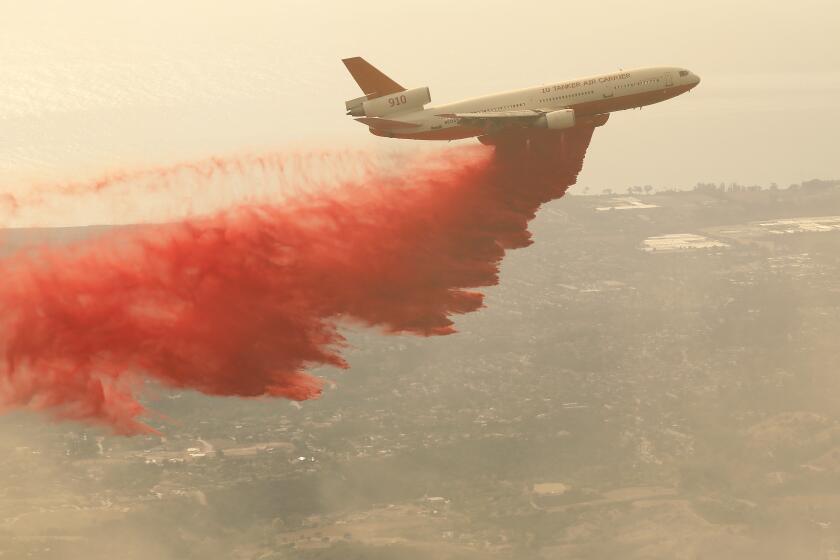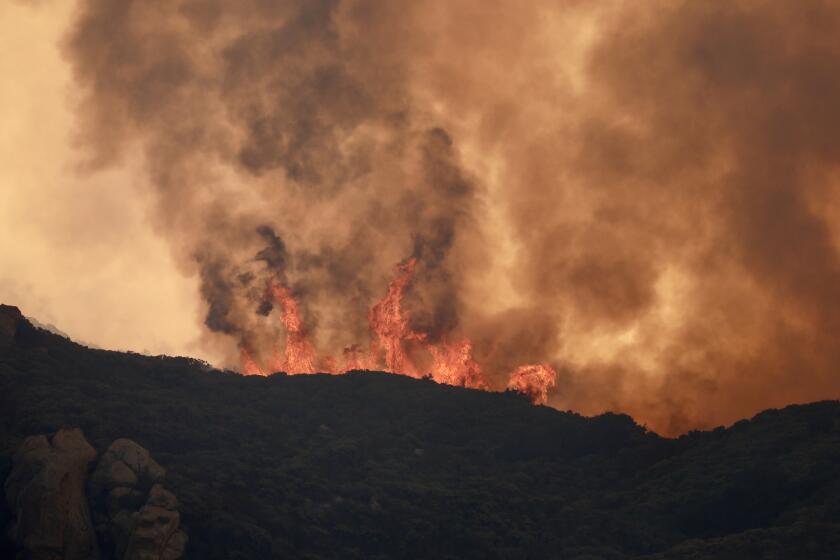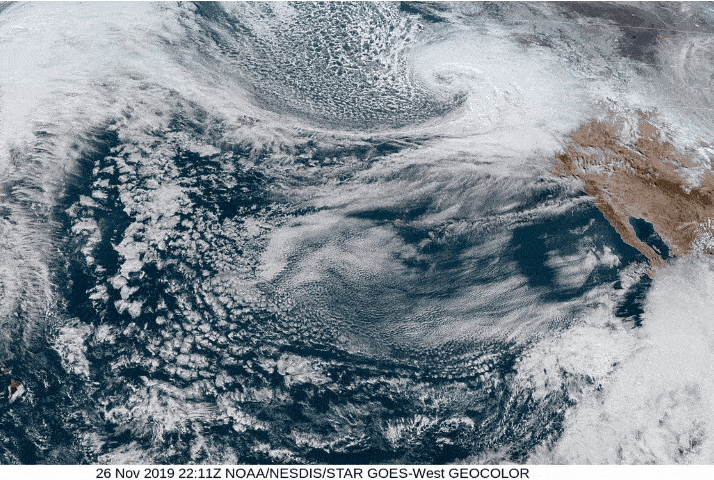Fire followed by rain in Santa Barbara brings relief along with anxiety
- Share via
SANTA BARBARA — Gordon Sichi rebuilt his house in the same spot where in 1990 he lost it to flames.
He loved this place — this cluster of homes in the mountains north of Santa Barbara — but the Painted Cave fire taught him a lesson. Through the years, he did what he could to protect the house, adding a metal roof, fire-resistant windows and a more-than-$90,000 system that, with a touch of a button on his phone, remotely causes sprinklers to douse the home with thousands of gallons of water.
When a wildfire again tore through these hills on Monday evening, Sichi decided not to evacuate with his wife. Instead, he drove to a hill that overlooks his community and stared at his home on his phone, thanks to night-vision cameras he’d installed near his chimney.
“My house is a castle,” Sichi said. “It’s my kids’ inheritance.”
For thousands of residents in the hills northwest of Santa Barbara, the Cave fire, which started just before sunset Monday, brought back terrifying memories of 1990, when in two hours flames ripped through the mountains and burned all the way to the sea, destroying more than 400 homes and killing a woman who tried to seek shelter from the fire in a creek behind her house.
And when they considered the forecast, they couldn’t help but think too of a more recent tragedy — the deadly 2018 Montecito mudslides that came when rain pelted the fresh burn scars of the Thomas fire. So this week, when residents prayed for rain, they asked for simple showers. Not torrents, not again, not like 2018.
Cave fire: Firefighters counting on rain to save the day, extinguish flames before they hit homes
This was the risky scenario playing out in Santa Barbara County on Tuesday, as firefighters and residents hoped the coming Thanksgiving week storm would slow the fire that was threatening homes, without unleashing a deluge that could cause more life-threatening damage.
The storm already was pounding Northern California with heavy snow and wind, closing Interstate 80 for periods and bringing steady rain to the Bay Area. Rain is expected to hit Southern California early Wednesday through Thursday, raising concerns about mudflows in burn areas and possible closure of major freeways like Interstate 5 and 15 due to snow.
In Sonoma County, where the Kincade fire burned tens of thousands of acres last month, officials issued a flash-flood watch for Tuesday, warning people who live downstream of the burn scar to prepare for rock slides, debris flows and flash flooding.
But much of the focus Tuesday was on Santa Barbara, where the autumn forces of fire and rain were converging.
On Tuesday, Julie Kummel stood at a lookout point in the mountains near her home and thought about the nearby blackened patch of ground — the burn scar.
“It won’t be pretty down there,” Kummel said. “There’ll be mudslides.”
Flash flood watches are in effect across the state as a cold front bringing rains rolls in to areas left vulnerable by wildfire.
The Cave fire started soon after 4 p.m. Monday. As the wind howled through the canyons, flames chewed down the hillsides toward communities in Santa Barbara and Goleta, spurring evacuations. But then, fire officials said, erratic winds twisted the flames in the opposite direction, sending them back up the steep, rocky terrain toward the firefighters.
The fire, which had burned more than 4,300 acres by Tuesday afternoon, seemed to be sprinting along Highway 154 on Monday night, said Santa Barbara County Fire Capt. Daniel Bertucelli. He was driving on the highway at 55 mph, he said, and the fire matched his pace.
Soon, backup firefighters from Ventura and L.A. counties arrived, and engines pulled into neighborhoods to defend homes in the fire’s path. Bulldozers and hand crews dug into the dirt, creating a containment line around the perimeter, hoping to stop the spread.
Cave fire: Residents thought they were safe, then the flames and smoke ‘began to blossom’
And by Tuesday afternoon, clouds had started to roll in. This time, it seemed, the rain gods had answered.
“This may be the rare situation where rainfall puts out a coastal Southern California wildfire,” said Daniel Swain, a climate scientist with UCLA and the National Center for Atmospheric Research.
Although the precipitation — part of an unusually cold weather front sweeping across the state — will likely tamp down, and maybe even end, the fire season, Swain said the rain also brought concerns of debris flows and flash flooding. Normally, Swain noted, there is some time between the fire season and the rainy season, when officials build berms to divert water and map out flood evacuation plans.
This time, he said, there will be “absolutely no time to do mitigation,” which, he noted, could be especially traumatic for Santa Barbara-area residents, who survived last year’s mudslides.
“Fire followed by rain,” he said softly. “That’s going to be tough for a lot of folks.”
The word ‘bombogenesis’ has been used to describe a rapidly deepening low-pressure system approaching Southern California, creating what is known as a ‘bomb cyclone’
On Monday evening in Santa Barbara County, a few miles from the flames of the Cave fire, Irene Lamberti, 90, was relaxing at home after her swim aerobics class. She’d seen smoke on her drive but doubted that she would need to evacuate, so she settled in for an episode of “Antiques Roadshow.”
Then around 8 p.m., an official knocked at the door and told her that people in her neighborhood were evacuating. Lamberti and her 88-year-old husband roamed their home, shoving items into a small suitcase. When they arrived at Goleta Valley Community Center, a shelter for evacuees, she realized they’d forgotten toothbrushes and her husband’s pajamas.
But, Lamberti said, they’d remembered something much harder to replace — a Japanese embroidery of a geisha that Lamberti had been working on for months.
“Our house is like a museum,” she said. “You can’t take everything. I wasn’t going to leave that.”
Although lesser in scale, this week’s fire was a somber echo of last year’s Camp fire, the deadliest in state history. For two years in a row, while some Californians rushed out to buy last-minute turkeys or headed to the airport to reunite with loved ones, others have followed a seasonal rhythm dictated by fire.
Last year, Thanksgiving in Paradise in the Camp fire’s aftermath meant meals at shelters and searching for silver linings. For one couple, it meant making peace with the loss of a beloved home in the forest. For another man, a recovering alcoholic who’d lost his home and was now yearning for a drink, it meant reminding himself that he was strong.
This year in Santa Barbara County, instead of packing for a Thanksgiving road trip, people scrambled to pack a lifetime of memories in a few minutes, along with a few clothes, medicine and family photos.
Then they drove away from their homes.
Miller reported from Santa Barbara, Gerber, Fry and Shalby from Los Angeles. Times staff writer Jaclyn Cosgrove in Los Angeles and Rong-Gong Lin II in San Fracnsico contributed to this report.
More to Read
Sign up for Essential California
The most important California stories and recommendations in your inbox every morning.
You may occasionally receive promotional content from the Los Angeles Times.






















